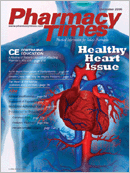Publication
Article
Pharmacy Times
A Pharmacist's Guide to OTC Therapy: Blood Pressure Monitors
Author(s):
In the United States, approximately32% of individuals aged 20 years andolder have hypertension. Furthermore,30% of individuals with hypertension arenot even aware that they have hypertension.1 Routine monitoring of blood pressure,along with proper treatment intervention,can significantly improvepatient outcomes as well as decrease anindividual's risk of the consequences ofuntreated hypertension. A wide varietyof blood pressure monitors are availablefor consumers to select from for routinemonitoring of their blood pressure in thecomfort of their homes. Pharmacists canbe a fundamental resource of informationfor those individuals attempting toselect a blood pressure monitor for self-monitoring.
Pharmacists can assist patients in theselection of a blood pressure monitor byassessing the needs of the patient, suchas ease of use, reliability, and accuracy,as well as cost. Pharmacists shoulddetermine if the patient clearly understandsthe testing procedure in order toensure accurate readings. Digital monitorsare the most common choice forhome use because of the ease of useand accuracy. Patients should be encouragedto compare the accuracy of theirreadings with their primary care doctor'sequipment when possible.
By educating patients on the importanceof routine self-monitoring of bloodpressure, pharmacists can assist patientsin becoming proactive about the managementof their blood pressure.
Ms. Terrie is a clinical pharmacy writerbased in Haymarket, Va.
For a list of references, send a stamped, self-addressedenvelope to: References Department,Attn. A. Rybovic, Pharmacy Times, AscendMedia Healthcare, 103 College Road East,Princeton, NJ 08540; or send an e-mailrequest to: arybovic@ascendmedia.com.







